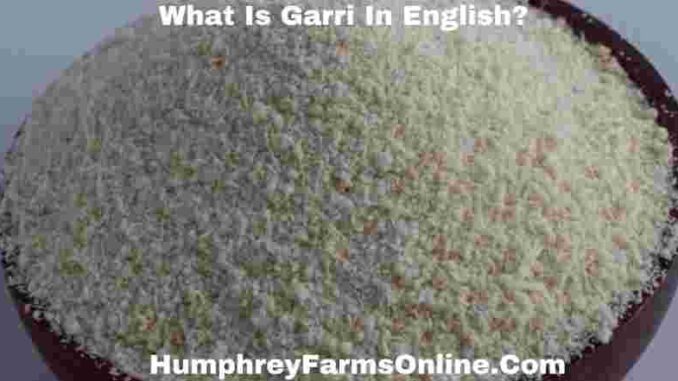
What Garri In English? Garri is a staple food in many West African countries, particularly Nigeria. It’s a versatile and beloved ingredient made from cassava, a root vegetable. But what exactly is garri, and how does it fit into a broader culinary context?
Also, Read
Understanding Garri
Garri is produced through a unique process that involves fermenting and frying cassava tubers. The resulting product is a coarse, granular substance that can range in color from white to yellow, depending on whether it has been mixed with palm oil. In English, garri is often referred to as “cassava flakes” or “cassava meal,” reflecting its origin from the cassava root.
How Garri is Made
The preparation of garri is both labor-intensive and intricate. Here’s a brief overview of the process:
- Peeling and Washing: Fresh cassava roots are peeled and thoroughly washed to remove dirt and impurities.
- Grating: The clean cassava is grated into a fine pulp.
- Fermentation: The cassava pulp is allowed to ferment for a few days. This step helps to reduce the cyanogenic glycosides, which are harmful compounds found in raw cassava.
- Pressing: The fermented cassava is then pressed to remove excess moisture.
- Roasting: Finally, the pressed cassava is roasted in a pan to create the crispy, flaky texture that characterizes garri.
Culinary Uses
Garri is incredibly versatile in the kitchen. It can be consumed in several ways:
- Soaked Garri: Often enjoyed as a snack or light meal, garri is soaked in water, sometimes with sugar, milk, or groundnut (peanut) added for extra flavor.
- Eba: When mixed with hot water and stirred to form a dough-like consistency, garri becomes eba, a popular accompaniment to various soups and stews.
- Fufu: In some regions, garri is used to make fufu, a staple food that can be paired with savory dishes.
Nutritional Profile
Garri is primarily a source of carbohydrates, which provide energy. It also contains dietary fiber, small amounts of protein, and various micronutrients like potassium and calcium. However, its nutritional content can vary based on how it’s processed and consumed.
The Cultural Significance
In many West African cultures, garri is more than just food; it’s a cultural icon. It is affordable, easy to prepare, and has been a part of the diet for generations. Its presence in everyday meals underscores its importance in providing sustenance and maintaining traditional culinary practices.
=================================
In English, garri might be described as “cassava flakes” or “cassava meal,” reflecting its origins and processing methods. Whether enjoyed as a snack or a meal component, garri remains a cornerstone of West African cuisine, celebrated for its versatility and cultural significance.
What Is Eba Garri In English?
Eba Garri is a traditional dish widely enjoyed across West Africa, particularly in Nigeria. This popular staple, known for its versatility and satisfying nature, is a staple in many households. But what exactly is Eba Garri, and how is it described in English?
Understanding Eba Garri
Eba Garri is essentially a food preparation made from garri, which itself is a product derived from cassava. To break it down:
- Garri: Garri is a granular, flour-like substance made from fermented and roasted cassava. It can vary in color, typically appearing as white or yellow, depending on the addition of palm oil during its preparation.
- Eba: When garri is mixed with hot water and stirred until it forms a dough-like consistency, it becomes Eba. This mixture is kneaded and allowed to cool slightly before being served.
In English, Eba Garri can be described as “cassava dough” or “cassava meal dough,” reflecting its main ingredient and the method of preparation.
How Eba Garri is Made
The preparation of Eba Garri involves a few simple steps:
- Boiling Water: Begin by boiling water. The amount of water used depends on how soft or firm you want the Eba to be.
- Mixing Garri: In a bowl or pot, gradually add garri to the boiling water while stirring continuously. This helps to prevent lumps from forming.
- Kneading: Once the garri has absorbed enough water, the mixture is stirred vigorously until it reaches a smooth, elastic consistency. This is the Eba, which should be pliable and slightly firm.
- Cooling: Allow the Eba to cool slightly before serving. It is typically eaten with various soups and stews.
Culinary Uses
Eba Garri is incredibly versatile and pairs well with a wide range of dishes. Common pairings include:
- Soups and Stews: Eba is often served with traditional soups such as Egusi (melon seed soup), Ogbono (wild mango soup), and Ogiri (fermented locust bean soup).
- Sauces: It can also be enjoyed with spicy and flavorful sauces made from meat, fish, or vegetables.
Nutritional Profile
Eba Garri primarily provides carbohydrates, which are a key energy source. It also contains dietary fiber, which aids digestion, and various minerals such as potassium and calcium. The nutritional content can vary depending on the specific type of garri used and how it’s prepared.
Cultural Significance
Eba Garri holds significant cultural importance in West African cuisine. It is a beloved staple due to its affordability, ease of preparation, and versatility. For many, it represents comfort food and a connection to traditional culinary practices.
===================================
In English, Eba Garri can be referred to as “cassava dough” or “cassava meal dough.” This traditional dish, made by mixing garri with hot water, is a cornerstone of West African cuisine. Whether enjoyed with hearty soups or flavorful stews, Eba Garri remains a staple food that reflects both the culinary richness and cultural heritage of the region.
What Is The English Name For Fufu?
Fufu is a staple dish in many West African countries, renowned for its versatility and rich cultural significance. But if you’re wondering about its English name or how to describe it in English, you’re not alone. Below, we provide clarity on what Fufu is and how it is referred to in English-speaking contexts.
Understanding Fufu
Fufu is a traditional food made from starchy vegetables or grains that are boiled, pounded, and formed into a smooth, elastic dough-like consistency. The primary ingredients used for making Fufu vary by region but commonly include:
- Cassava: A root vegetable that is boiled, pounded, and combined with other ingredients.
- Yam: A tuber similar to potatoes, also boiled and pounded to make Fufu.
- Plantains: A type of banana that is boiled and pounded to create a smooth dough.
- Corn: Sometimes used in combination with other starchy ingredients.
English Description of Fufu
In English, Fufu doesn’t have a direct translation but can be described as “starchy dough” or “fermented dough.” These terms capture the essence of Fufu, highlighting its texture and preparation process:
- Starchy Dough: This term reflects the primary characteristic of Fufu, which is its smooth, dough-like consistency created from starchy ingredients.
- Fermented Dough: In some regions, Fufu may be fermented before cooking, which adds a unique flavor and texture to the dish.
How Fufu is Made
The preparation of Fufu involves several key steps:
- Boiling: The chosen starchy ingredient (cassava, yam, plantain, etc.) is boiled until it becomes tender.
- Pounding: The boiled ingredients are then pounded or mashed until they form a smooth, elastic dough. This can be done using traditional methods, such as a mortar and pestle, or modern equipment.
- Forming: The mixture is shaped into a soft, pliable dough that can be used as an accompaniment to various soups and stews.
Culinary Uses
Fufu is typically served as a side dish with a variety of soups and stews. Common pairings include:
- Meat Stews: Fufu is often enjoyed with rich, spicy stews made from beef, goat, or chicken.
- Vegetable Soups: It pairs well with soups made from vegetables like spinach or okra.
- Fish Dishes: Fufu complements fish-based stews and sauces.
Nutritional Profile
Fufu is a good source of carbohydrates, providing energy and aiding in digestion due to its fiber content. The nutritional profile may vary depending on the base ingredient used and the preparation method.
Cultural Significance
Fufu holds significant cultural importance in West African cuisine. It is cherished for its versatility and its role in traditional meals, symbolizing hospitality and communal eating. It is a common feature in celebrations, family gatherings, and everyday meals.
=======================================
While there is no direct English name for Fufu, it can be described as “starchy dough” or “fermented dough,” reflecting its texture and preparation. This traditional dish, made from various starchy ingredients, is an integral part of West African cuisine. It is enjoyed with a range of soups and stews, making it a beloved and essential part of the culinary landscape in many cultures.

Leave a Reply
You must be logged in to post a comment.